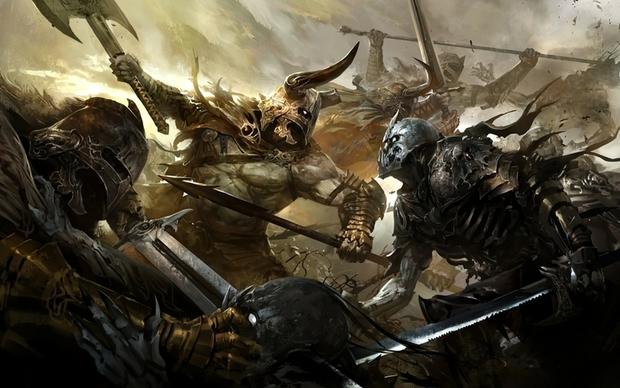Knowing exactly how to write a battle scene in a book isn’t always clear. Battles, by their very nature, are chaotic scenes involving maybe thousands of people. There are logistical considerations and cause-and-effect matters to consider too. For example, you could write a battle scene in a book that involves the siege of a castle. If the walls of that fortification collapse, what impact does that have on the battle? We cover much more in this guide, but first, let’s look at the pitfalls of writing battle scenes.
The Pitfalls Of Writing A Battle Scene
One of the biggest potential pitfalls when it comes to writing a battle scene is in the description. With so much to get across, readers can become overwhelmed and may grow frustrated if the writing isn’t clear.
Some of the best bits of advice I’ve found come from bestselling author, Brandon Sanderson. He echoes this key aim of achieving clarity but adds two more recommendations: balancing blow-by-blow descriptions and utilising showing instead of telling. Let’s look at things in more detail.
How To Write A Battle Scene In A Book
So how do we write a battle scene in a book with these three guiding principles in mind?
Well, depending on the type of combat situation you want to feature, you may find that some apply more than others.
In large battles, for instance—we’re talking Minas Tirith and Helms Deep big—clarity is everything. It’s our job to bring order to the chaos.
We can achieve this by doing something I mentioned earlier—mapping it out. It’s by far one of the best ways of writing battle scenes. So, in true fantasy warlord style, roll out your great sheet of parchment and draw out your combat situation.
Is it going to be open warfare or a siege? Let’s look at the former first.
Note down details of the landscape. This is where worldbuilding can come in handy. Is it flat or hilly? Are there any waterways like streams or rivers? If so, are there bridges? Any rocky outcroppings, dense bushes or long grass. When it comes to war, anything like this can make a difference.
Next, position your warriors with the terrain in mind. And play out your battle. Examine the strengths and weaknesses of each side. What counter-attacks could you introduce, like surprise cavalry charges to the flank?
How To Write Battle Scenes Involving Sieges
Writing battle scenes involving sieges is a little different. With defenders holed up in a castle, it’s up to the attackers to breach the walls.
First, it helps to detail the defensive fortifications in place. Then ask how can they be broken. Determine any weak spots and see how they could be exploited or how they could be heroically defended.
It definitely helps to do your research when it comes to this, especially if you’re struggling. In doing so you gain a deeper understanding of the ebbs and flows of warfare and the factors that can prove decisive. Plus, you’ll come across awesome details to inspire your own stories.
To help you out, I have detailed guides to medieval castles, making maps and battle tactics you can check out. Plus I’ve added some extra links below.
Writing Battle Scenes And The Use Of Perspectives
Another great tool you can use to help achieve clarity in the writing of battle scenes is perspectives or points of view.
In times of old, once battle was joined, it was hard for order and control to be maintained by military leaders. That’s why the likes of helmet plumes, coloured tabards and bannerman appear in battles, as well as horns, drums and other instruments—to help maintain order.

If the story is told in a narrow perspective, for instance in the first-person viewpoint or third-person limited, it may jar the flow of the story to start discussing how the battle was going on the left flank if that character is battling in the centre.
But it’s important to show the reader the image of the overall battle as it develops. To achieve this we can introduce new perspectives. Bringing forward or introducing secondary characters to primary points of view can allow us to explore different parts of the battle.
And from a writing perspective, this can work wonders structurally, allowing you to create mini cliffhangers as the battle unfolds. A surefire way to keep readers hooked. It’s something I used in Pariah’s Lament and one that went down a storm with readers and reviewers.
Battles Scenes And Showing Not Telling Action
Before we move on, a word on show v tell in large battles. For me, showing serves a crucial role. Zooming out from intimate fighting, you can truly immerse the reader into the madness around the characters—the blood and gore, wails and howls of man and horse, the stench of blood and sweat and fear. The reader can transport there. Stand amongst the chaos whipping all around them.
By showing more than telling, you can help create that experience for the reader.
And as for blow-by-blow descriptions, as you may have guessed they play less of a role here. But that’s not to say it’s banished. Blow-by-blow exposition is necessary for writing all fight scenes. In large-scale combat, exciting and dramatic bursts of blow-by-blow work a treat. Because it’s realistic to what battles were like in medieval warfare. Pages of it, however, might cause frustration. So there are some tips on how to write a battle scene in a book. If you’d like to learn more about writing conflict, see this guide below: Head Here To Learn How To Write A Fight Scene In A Book
- Mastering Dialogue: The Very Best Tips - January 12, 2024
- The Proven Method Of Writing Short Story Cover Letters - November 10, 2023
- Tips, Advice And Guidance On Writing Villains And Antagonists - November 7, 2023

